
This is a test
- 240 pages
- English
- ePUB (mobile friendly)
- Available on iOS & Android
eBook - ePub
Book details
Book preview
Table of contents
Citations
About This Book
This carefully researched volume offers lovers of both costume and the medieval period a meticulously researched and accurately detailed study of the clothing of the Middle Ages. Following an illuminating discussion of the style and construction of costumes worn in the thirteenth, fourteenth, and fifteenth centuries, noted costume historian Mary G. Houston provides detailed descriptions and illustrations of actual apparel worn by all classes and sectors of society. Included are elaborate royal, academic, and legal costumes; Eucharistic vestments and garments of religious orders; working class apparel; civilian dress; and more. Also examined is a wide variety of accessories and ornaments, jewelry, armor, textiles, embroidery, coiffures, and other items.
The clear, succinct text is splendidly documented by 350 black-and-white line illustrations based on contemporary books and manuscripts as well as representations in paintings and sculpture. Indispensable for students of costume history, medievalists, illustrators, and fashion historians, Medieval Costume in England and France will delight anyone interested in the medieval period and its dress.
The clear, succinct text is splendidly documented by 350 black-and-white line illustrations based on contemporary books and manuscripts as well as representations in paintings and sculpture. Indispensable for students of costume history, medievalists, illustrators, and fashion historians, Medieval Costume in England and France will delight anyone interested in the medieval period and its dress.
Frequently asked questions
At the moment all of our mobile-responsive ePub books are available to download via the app. Most of our PDFs are also available to download and we're working on making the final remaining ones downloadable now. Learn more here.
Both plans give you full access to the library and all of Perlego’s features. The only differences are the price and subscription period: With the annual plan you’ll save around 30% compared to 12 months on the monthly plan.
We are an online textbook subscription service, where you can get access to an entire online library for less than the price of a single book per month. With over 1 million books across 1000+ topics, we’ve got you covered! Learn more here.
Look out for the read-aloud symbol on your next book to see if you can listen to it. The read-aloud tool reads text aloud for you, highlighting the text as it is being read. You can pause it, speed it up and slow it down. Learn more here.
Yes, you can access Medieval Costume in England and France by Mary G. Houston in PDF and/or ePUB format, as well as other popular books in Design & Fashion Design. We have over one million books available in our catalogue for you to explore.
Information
Topic
DesignSubtopic
Fashion DesignCHAPTER I
THE CONSTRUCTION OF THIRTEENTH-CENTURY COSTUME
IT will help towards a clearer understanding of the style, if the illustrations of the flat patterns are studied, previously to those illustrations showing the costumes in wear, and when these latter are described, each drawing will be referred back to the flat pattern to which it pertains.
In general the costumes of this century are cut on the simplest geometric plans and, except for a few very early examples, there is no attempt to fit the figure as was seen in the twelfth and again in the fourteenth and fifteenth centuries. Undoubtedly this extreme simplicity of construction gives the great dignity of line which is the outstanding feature of thirteenth-century costume and which is only equalled by that of the dress of ancient Greece—Ecclesiastical Costume of the century will be treated of separately. Though there is little real difference between Ecclesiastical and Civil Dress at this period as far as the cutting out is concerned, it will be found more convenient to refer to the two types apart from one another.
EARLY EXAMPLES
Figs. 1 to 6 are taken from types in wear about the year 1200.
Fig. 1. This is the plan of a man’s tunic, reaching to the middle of the calf. The points distinguishing it as of early date are : first, the wide decorated band at neck ; second, the large gusset at the armhole, extending almost to the waist. This tunic was also worn full length and in the latter form was worn by women as well as by men. The wide armhole persisted till the middle of the century.
Fig. 2. Here we have a full length woman’s tunic. The points to note in this as giving the date are : first, the broadbanded decoration at neck ; second, the comparatively tight fit of the upper part ; third, the long hanging cuffs, a survival of the period of the exaggeratedly long sleeves of the eleventh and twelfth centuries.
Fig. 3. This is the semicircular cloak worn by both sexes, at least as early as the sixth century A.D. and continuously till the thirteenth century. In the thirteenth century it was gradually superseded by a circular or almost circular garment. It was worn in various ways, either fastened with a brooch on the right shoulder (this method more commonly by men), or was wrapped round the figure in various ways, and it was occasionally worn with the opening at centre front. In this last position it was clumsy round the shoulders, and for that reason, no doubt, an improvement was made (see dotted line). This was the cutting out of a curved notch for the neck. There is a large coloured drawing, in plan, of an actual thirteenth-century garment of this type in Bock’s Die Kleinodien des Heiligen Römischen Reiches Deutscher Nation. This is the Imperial Mantle (Paludamentum Imperiale) of the Emperor Otto IV. (1208–1212).
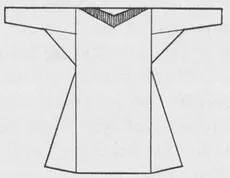
Fig. 1.
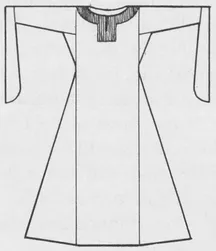
Fig. 2.
Fig. 4. This garment appears to be derived from that wide rectangular seamless robe of very ancient origin, which we find in Egypt as long ago as 1450 B.C. and in Persia (“The Royal Robe of Persia”) in the sixth and fifth centuries B.C. It continued in wear in Western Asia before and after the Christian era and in later times it is to be seen on a Romano-Byzantine Consular Ivory, fifth century A.D. (that of Stilicho and his wife Serena from the Cathedral of Monza). No longer rectangular, in the thirteenth century, but with the upper part curved inwards we find it cut as shown in the plan ; we note also the lower part is considerably narrower and seamed down at each side. Viollet-le-Duc calls this garment the “esclavine” and gives an alternative method of cutting it, see dotted lines. It persists through the thirteenth century as late as 1290 (tomb in Chalons-sur-Marne Cathedral) and is seen in an early fourteenth-century manuscript (Somme du Roi, B.M. MSS. Add. 28162, also Add. 17341, late thirteenth century). It is described in Vetusta Monumenta, Vol. VI., Plate XXXIX., as the “sclavine.” Here the garment is worn by a figure of St. John the Evangelist, as a pilgrim (which is reproduced from the original in the “Painted Chamber” at Westminster). A hood is usually attached to the sclavine during the latter years of its wear in the thirteenth century.
Fig. 3.
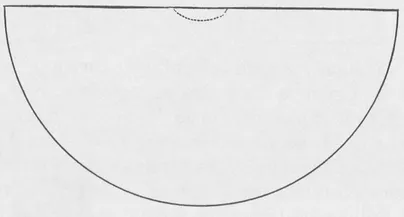

Fig. 4.

Fig. 5.
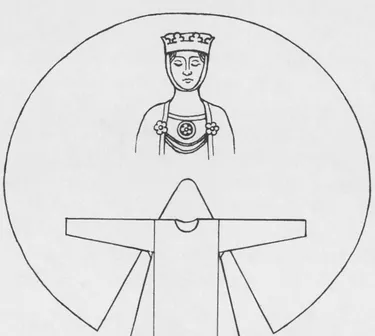
Fig. 7.
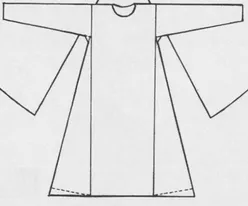
Fig. 8.
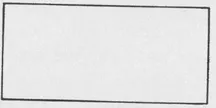
Fig. 6.
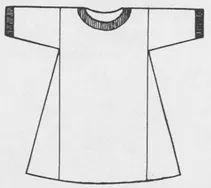
Fig. 9.
Fig. 5. Shows a cape-like garment or mantle characteristic of the early years of the thirteenth century. In England it appears in Saxon times, worn both by men and women (B.M. MSS. Cott. Claudius B. IV. and Harl. 2908). Where the representations show it full and voluminous, it would be cut as shown—simply a rectangular piece of stuff folded over and the front shortened more or less and rounded off, then a hole cut for the head. Other representations suggest a cut akin to certain early “extinguisher”-shaped chasubles of the period, and the construction would be more as shown by the dotted line. This latter shape restricts to some degree the movement of the arms. Fig. 5 does not persist through the century and, on the whole, it is rare even at the commencement.
Fig. 6 is the veil, head-cloth, peplum, couvre-chef, of almost universal wear by women during the thirteenth century. It was not, as a rule, quite so voluminous as that worn in the twelfth. Full scale, it measures about 22 inches across, and is rather more than double this in length. Towards the end of the century, women of position discarded it for more elaborate head-dresses, but it persisted for working-class women and elderly widows and still survives among the religious orders.
The methods of dressing the hair in the thirteenth century are easily understood when the illustrations of male costume are examined ; but in cases where the women’s heads are covered, it should be said that, for the most part, the hair was parted in the centre and dressed in two plaits, which were crossed at the back and then bound round the head. At the end of the century some figures show that each plait is coiled round above the ears, giving what was called the “ram’s horn” or, as we should now phrase it, “earphone” style.
That padding was used as well is easily seen when some of the head-dresses of the end of the century fashions are examined. Young girls wore their hair flowing naturally down their backs, at times confined by a fillet or chaplet. Widows wore the wimple, or gorget, round the face and the veil over their heads, in similar style to the head-coverings of the Religious Orders.
MID-CENTURY TYPES
Fig. 7. This is the almost circular cloak worn by both sexes, but more especially by women, from an early period till the close of the century. It persisted into the fourteenth and fifteenth centuries, more especially in traditional royal costume, when its simple dignity suited well a great occasion and its folds displayed the beauties of richly patterned silks. The method of fastening is shown in the small drawing of a woman’s head and shoulders, superimposed (Countess Gleichen, A.D. 1260, from Jacquemin). The fastening consists of a small metal boss at either side, and this is furnished with a ring at the back, through which runs a cord or chain. This c...
Table of contents
- Title Page
- Copyright Page
- INTRODUCTION
- Table of Contents
- CHAPTER I - THE CONSTRUCTION OF THIRTEENTH-CENTURY COSTUME
- CHAPTER II - REGAL COSTUME IN THE THIRTEENTH CENTURY
- CHAPTER III - AN INTRODUCTION TO ECCLESIASTICAL COSTUME AND THAT OF THE RELIGIOUS ORDERS, TOGETHER WITH THIRTEENTH - CENTURY EXAMPLES OF THE SAME
- CHAPTER IV - CIVILIAN DRESS OF THE THIRTEENTH CENTURY
- CHAPTER V - ARMOUR IN THE THIRTEENTH CENTURY AND DETAILS FROM METAL ORNAMENTS
- CHAPTER VI - THIRTEENTH-CENTURY ORNAMENT AS APPLIED TO TEXTILES AND EMBROIDERIES
- CHAPTER VII - THE STYLE AND CONSTRUCTION OF FOURTEENTH-CENTURY COSTUME
- CHAPTER VIII - REGAL AND ECCLESIASTICAL COSTUME IN THE FOURTEENTH CENTURY
- CHAPTER IX - CIVILIAN DRESS IN THE FOURTEENTH CENTURY
- CHAPTER X - ARMOUR IN THE FOURTEENTH CENTURY, AND DETAILS FROM METAL ORNAMENTS
- CHAPTER XI - FOURTEENTH-CENTURY ORNAMENT CHIEFLY CONSIDERED AS APPLIED TO WOVEN MATERIALS AND EMBROIDERIES
- CHAPTER XII - THE STYLE AND CONSTRUCTION OF FIFTEENTH-CENTURY COSTUME
- CHAPTER XIII - REGAL, ECCLESIASTICAL AND ACADEMIC COSTUME
- CHAPTER XIV - CIVILIAN DRESS OF THE FIFTEENTH CENTURY
- CHAPTER XV - ARMOUR IN THE FIFTEENTH CENTURY AND DETAILS FROM METAL ORNAMENTS
- CHAPTER XVI - FIFTEENTH-CENTURY ORNAMENT AS APPLIED TO WOVEN MATERIALS AND EMBROIDERIES
- GLOSSARY
- BIBLIOGRAPHY